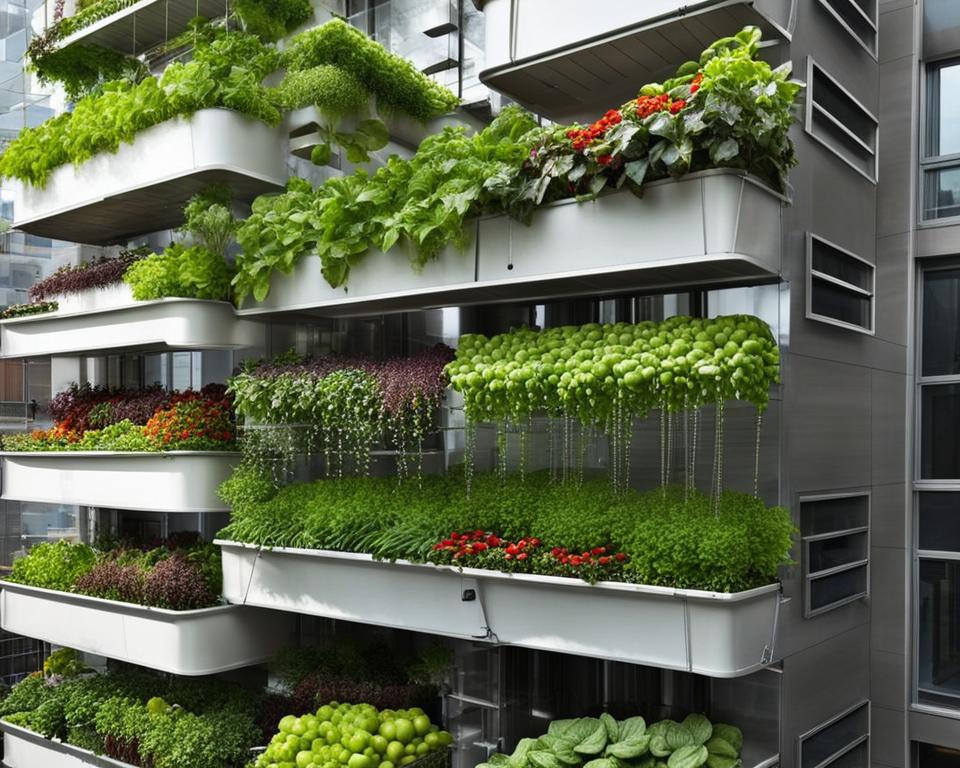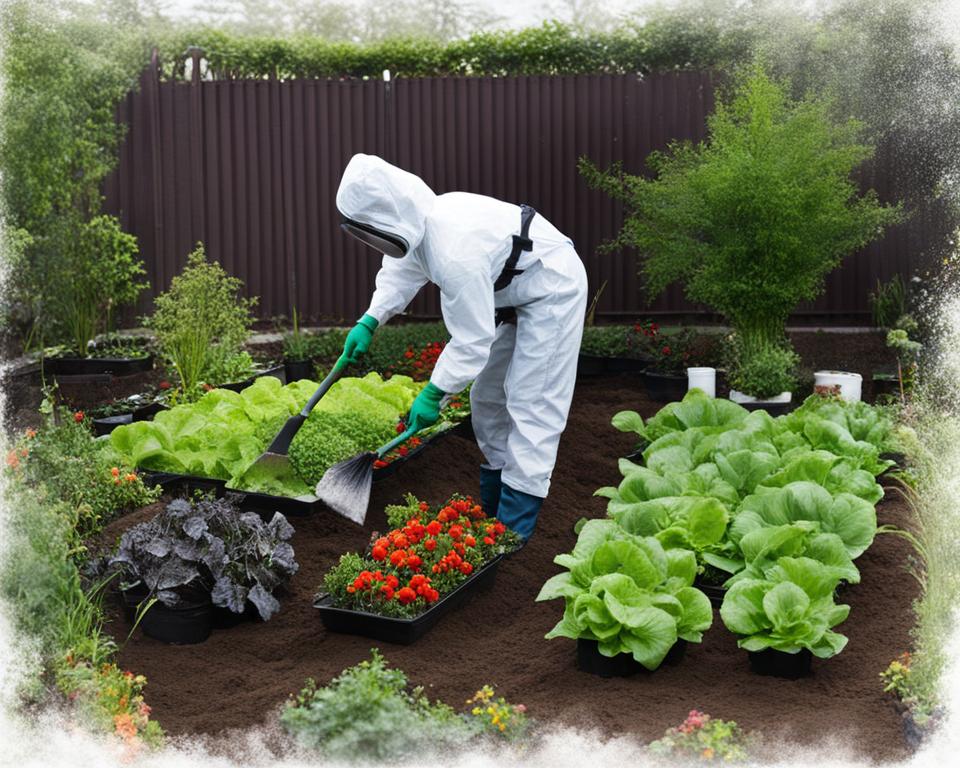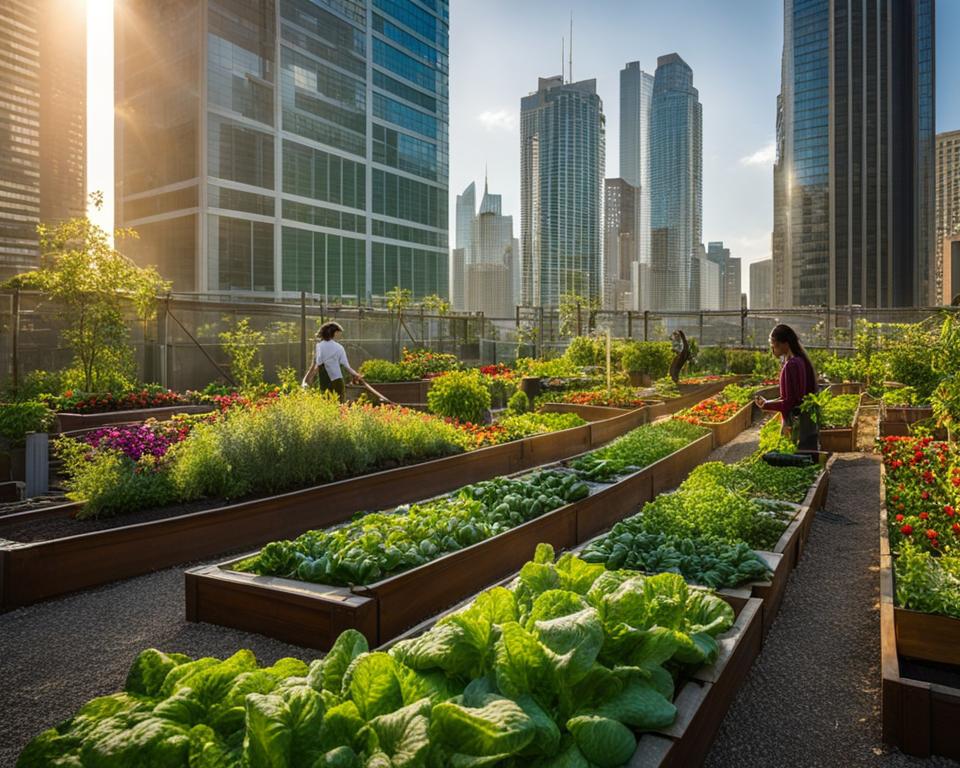Have you ever considered the fresh, vibrant flavors of home-grown tomatoes or the crispness of lettuce picked right from your balcony? Urban gardening presents an array of enticing benefits, opening a door to sustainability and health right in the heart of the city. Whether you possess a tiny apartment ledge or a modest community plot, the positive aspects of urban gardening can transform city living into a verdant paradise. With a touch of creativity and a pinch of dedication, you can harness the urban gardening perks that range from educational enrichment to ecological contribution. There are myriad reasons to start urban gardening, and once you begin, you’ll uncover more layers to this fulfilling endeavor.
Key Takeaways
- Discover the rewarding experience of producing your food within an urban landscape.
- Learn how urban gardening guarantees fresh, healthy produce and mitigates food desert issues.
- Understand the sustainable advantages, like reduced carbon footprint, that urban gardening offers.
- Explore how your garden can serve as a catalyst for community connection and education.
- Find financial benefits through lowered grocery bills and potential income from excess produce.
- Recognize the empowerment that comes with controlling the quality of food on your table.
Embracing Space Efficiency in Urban Gardening
For city dwellers looking to reap the benefits of gardening in the city, embracing space efficiency in urban gardening is not just a trend—it’s an essential technique in the savvy urbanite’s arsenal. By transforming minimal and often under-appreciated spaces into lush patches of greenery, you can enjoy the satisfying crunch of homegrown produce and the tranquility of a personal green space. Let’s delve into two inventive methods that maximize yield in confined urban environments.
Exploring Vertical and Container Gardening
When square footage is at a premium, the solution lies in looking up. Vertical and container gardening allow you to exploit every inch of your small patio or balcony with a touch of creativity. Climbing plants, tiered planters, and trellises turn a bare wall into a living mosaic of greens, herbs, and vegetables. Containers offer endless possibilities; from repurposed buckets to designer pots, they enable you to manage soil quality and move your garden with the sun’s arc or city shadows.
Maximizing Rooftop and Hydroponic Approaches
Rooftop gardens are underutilized oases that afford a bird’s-eye view and a bounty of fresh produce. Coupled with hydroponic systems that require no soil, rooftops can be converted into high-yielding, lush gardens. Hydroponics brings the space efficiency in urban gardening to a new level, drastically cutting down the space typically needed for traditional gardening methods and allowing your plants to thrive with nutrient-rich solutions.
| Technique | Space Used | Maintenance | Yield Potential |
|---|---|---|---|
| Vertical Gardening | Walls & Fences | Medium | High |
| Container Gardening | Patios, Balconies | Variable | Medium-High |
| Rooftop Gardening | Rooftops | High | High |
| Hydroponic Systems | Any indoor space | Low | Very High |
Each of these methods comes with its own set of urban gardening advantages. Whether through the lush vertical facades or the innovative and efficient hydroponic systems, these techniques ensure that even the smallest spaces yield fresh and heartening results. By incorporating these approaches into your urban dwelling, you not only contribute to the beautification and betterment of your personal living space but also participate in a global movement towards sustainable and responsible living. Start your journey into urban gardening and witness the transformation of your concrete surroundings into a verdant, vibrant sanctuary.
What Are Some Benefits Related to Urban Gardening
Engaging in urban gardening offers more than just an abundance of fresh produce right at your doorstep. It’s a holistic approach that intertwines multiple facets of well-being and education with every plant you nurture. Let’s delve into how this practice can bring about profound changes in your life, both nutritionally and intellectually.
Educational Aspects of Cultivating Your Garden
One of the standout educational aspects of urban gardening is the hands-on experience it provides. As you cultivate your little slice of nature, you’re endowed with the knowledge of plant cycles, composting, and the intricacies of creating a sustainable mini ecosystem. It’s an ongoing lesson in patience, responsibility, and environmental stewardship. The practical skills acquired pave the way for a deeper understanding of ecological balance and food sources, making you more self-reliant and ecologically conscious.
Health and Nutritional Advantages
There is an undeniable connection between your garden and your health. The health benefits of urban gardening are plentiful, ranging from mental well-being to physical fitness. Managing your garden can serve as a tranquil retreat from the hectic city life, offering stress relief and a sense of accomplishment. Furthermore, the physical activity involved in gardening—be it digging, planting, or weeding—contributes positively to your physical health. But it doesn’t stop there.
Eating what you grow not only deepens your relationship with food but also ensures that your meals are packed with the necessary vitamins and nutrients without the harmful presence of pesticides. The tendency to include more fruits and vegetables in your diet inherently springs from having a personal harvest, which is instrumental in combating prevalent health concerns such as obesity, heart disease, and diabetes. Thus, urban gardening is a gateway to a healthier lifestyle, both mentally and physically.
In conclusion, the benefits related to urban gardening reach far beyond what meets the eye. It’s an enriching endeavor that nurtures the body, mind, and soul, proving that even the smallest urban garden can have a significant impact on your life. So, why not start cultivating your educational journey and health sanctuary today?
Enhancing Dietary Health with Home-Grown Foods
When you take control of cultivating your own nutritious home-grown foods, you begin a rewarding journey towards enhancing dietary health. Your urban garden can be a source of pride and a cornerstone of your daily nourishment. Imagine relishing a salad crafted from vegetables picked fresh from your balcony garden or herbs snipped right from your windowsill—this is the essence of enjoying organic urban produce.
The benefits of nurturing an edible garden at home extend beyond the pure joy of gardening. Here’s what you should know about how home-grown foods profoundly influence your well-being:
- Chemical-Free Goodness: By growing your food, you ensure that the produce you consume is free from harmful pesticides and chemicals often found in commercially farmed produce.
- Peak Nutritional Value: The time from garden to plate is minimal, meaning your fruits and vegetables retain more of their nutritional content, unlike store-bought options that may have lost vital nutrients during transport.
- Healthy Eating Habits: Having readily available produce promotes the inclusion of more fruits and vegetables in your diet, a habit that has been linked to a reduction in lifestyle diseases.
- Emotional Well-being: The act of gardening itself is therapeutic, reducing stress and providing a sense of accomplishment. Plus, there’s no better feeling than eating food you’ve grown yourself!
By adding more organic urban produce to your diet, you not only enjoy fresher, tastier ingredients but also take a significant step towards a healthier lifestyle for you and your family. So, dig in, get your hands dirty, and savor the bounty that your urban garden provides. After all, the shortest path to healthy eating is the one that leads directly from your garden to your plate.
Addressing Urban Food Deserts

Urban food deserts are a major challenge across cities in the United States, with far-reaching consequences for individuals and communities who face difficulties in accessing affordable and nourishing food. The transformative power of urban gardening steps in as a key to alleviating food insecurity by providing fresh produce in areas where grocery stores are scarce or too costly. In this section, we’ll delve into how urban gardening contributes to environmental sustainability and helps individuals and communities tackle the barriers created by food deserts.
Whether you’re living in an apartment with a small balcony or have access to a rooftop, urban gardening enables you to cultivate a variety of fruits and vegetables, thus addressing urban food deserts at a personal and community level. By growing your own food, you not only gain access to fresh produce but also contribute to the broader goal of alleviating food insecurity and enhancing dietary quality for everyone around you.
Urban gardens are more than just food sources; they are beacons of hope in concrete jungles, providing green spaces that nourish both the body and the community.
The benefits of urban gardening for the environment cannot be overstated. Reducing the reliance on food transportation lowers carbon emissions, making urban gardening a sustainable choice that directly benefits the health of our planet. Furthermore, these green spaces act as natural air purifiers, contributing to cleaner, healthier urban environments.
Let’s consider the profound impact urban gardening can have:
| Impact | Description | Benefit |
|---|---|---|
| Access to Fresh Produce | Provides fresh vegetables and fruits in areas without supermarkets. | Direct source of nutrition, improves dietary habits. |
| Educational Opportunities | Teaches valuable skills in sustainable living and food cultivation. | Empowers individuals, especially children, with knowledge of food sources. |
| Economic Savings | Reduces the need to purchase expensive produce. | More disposable income, potential for community markets. |
| Environmental Improvement | Decreases carbon footprint and increases urban biodiversity. | Supports a healthier ecosystem and mitigates climate change effects. |
Embrace the act of urban gardening, not only for its potential to beautify the urban landscape but as a critical movement for food justice—an initiative that redefines grassroots action, quite literally from the ground up. Together, we can transform our cities and ensure that everyone has the opportunity to taste the fruits of their own labor.
The Superior Quality of Home-Grown Produce
Is there anything more satisfying than biting into a crisp, freshly picked tomato right from your own garden? The superior quality of home-grown produce isn’t just about the burst of flavor—it speaks to the heart of urban gardening and its role in refining our food sources. When you grow fruits and vegetables yourself, you’re not just harvesting food; you’re cultivating a healthier lifestyle and promoting a sustainable environment.
One of the cornerstones of cultivating elevated-quality produce is the ability to manage and reduce the use of chemicals. In today’s urban farming, you have the chance to embrace more natural cultivation methods, thereby reducing chemicals in urban farming. This translates into safer, cleaner, and more wholesome food for you and your family. Let’s delve into what makes this possible.
Reducing Chemicals and Pesticides
Gone are the days of relying on harmful substances to manage garden pests and diseases. By minimizing chemical use, you ensure that every bite of your home-grown food is not only tastier but also free from potentially hazardous pesticides. This clean approach to urban gardening can lead to an improved ecosystem right at your doorstep and is a responsible choice for your health and the planet’s well-being.
Growing Heirloom and Organic Varieties
If variety is the spice of life, then heirloom and organic urban gardening are the ingredients that enrich it. Distinctive and rare heirloom varieties offer a treasure trove of flavors and textures that are often lacking in commercial agriculture. By choosing to grow these heritage strains, you aren’t just enjoying fruits and vegetables at their finest; you’re also playing a part in preserving biodiversity. Opting for organic practices further enhances the superior quality of your home-grown produce, making each harvest not only a treat for the palate but also a triumph for gardening craftsmanship.
Embrace the wisdom of our predecessors and the innovation of modern organic practices, and you will see that both the value and the values of what you grow escalate. Take pride, urban gardeners, for with each seed you sow, you’re cultivating a legacy of health, heritage, and environmental stewardship right at home.
Benefits of Gardening in the City: Year-Round Harvests

Urban gardening offers you the remarkable advantage of enjoying year-round harvests, meticulously weaving urban gardening benefits into the fabric of city living. By embracing innovative cultivation techniques such as container gardening and hydroponics, you can bypass the limitations imposed by traditional seasonal cycles.
These modern methods provide distinct advantages of urban gardening, allowing plants to thrive despite fluctuating urban temperatures and space constraints. Whether you’re nestled in the heart of a bustling metropolis or occupying a cozy suburban nook, your urban garden can flourish, affording you the luxury of farm-fresh produce throughout the year.
Imagine savoring the taste of ripe tomatoes in December or picking fresh basil in the chill of February. This dream is a palpable reality in the realm of urban agriculture. Here’s a closer look at what you can achieve with a well-managed urban garden:
- Consistent access to pesticide-free vegetables and herbs
- The delight of picking fresh produce regardless of the season
- Creating a sustainable and personal food source that’s kind to the environment
Urban gardeners utilize smart gardening practices that adapt to their unique living situations, ensuring a perpetual supply of greens and thus reinforcing the advantages of urban gardening.
| Harvest | Season | Technique |
|---|---|---|
| Tomatoes | Year-round | Hydroponic |
| Leafy Greens | Year-round | Container |
| Herbs | Year-round | Indoor Window Boxes |
| Strawberries | Year-round | Vertical Towers |
Urban gardening not only transforms your culinary experiences but also contributes to your health and well-being, providing fresh, nutrient-rich foods outside of traditional harvest seasons. With a little bit of innovation and care, you’ll see how year-round harvests are within reach, a testament to the resourcefulness embedded in city cultures.
Positive Impacts of Urban Gardening on the Environment
Urban gardening is blooming across city landscapes, not only beautifying these spaces but also serving a greater purpose. By nurturing your own garden in the urban sprawl, you’re contributing to a healthier planet. Let’s delve into the environmental benefits that your green thumb facilitates.
Carbon Footprint Reduction Through Localized Growth
One of the most compelling positive environmental impacts of urban gardening is its ability to shrink the carbon footprint of our food. When produce is grown right where it’s consumed, we see a drastic cut in the emissions associated with transportation. This localized growth spares the air and energy otherwise spent on shipping food items from remote farms to urban centers. With each urban garden, you’re effectively taking a stand against climate change, one seedling at a time.
Efficient Water Usage with Innovative Gardening Techniques
Another environmental boon is urban gardening water efficiency. Urban gardens often employ innovative techniques like drip irrigation or hydroponic systems, which dramatically lower water usage. With heightened efficiency, urban gardens can operate with up to 90% less water than their rural counterparts. Besides conserving a precious resource, such water-smart practices also pave the way for sustainable urban living.
| Method | Water Savings Potential | Benefits |
|---|---|---|
| Drip Irrigation | 30-50% | Directs water to the root zone, minimizes evaporation |
| Hydroponics | Up to 90% | Circulates water, reduces waste, and requires no soil |
| Rainwater Harvesting | Varies | Utilizes natural precipitation, reduces runoff |
By embracing these gardening practices, not only do you become a steward of the environment, but you also join a growing movement towards sustainable urban development. Your efforts, no matter how small, contribute significantly to the collective action needed to nurture our planet.
Ensuring Food Safety in Your Backyard

When you take the reins in localizing food production, you are taking a proactive step towards ensuring food safety right outside your door. In the heart of the city, urban gardening safety is more than a benefit; it’s a method of maintaining control over what ends up on your plate. This sense of control extends to all facets of the gardening process, from the selection of soil to the careful management of water and natural fertilizers.
Consider the journey of a tomato in a typical supply chain: from the farm to the packing house, then onto a truck, and finally, it reaches the supermarket shelf. Each step carries its own set of risks, increasing the likelihood of contamination. Contrast this with one grown in your own urban garden. The difference is stark—you handle the fruit from seed to harvest, virtually eliminating numerous potential contamination points.
| Supply Chain Stage | Risks in Mass Production | Risks in Urban Gardening |
|---|---|---|
| Harvesting Process | Potential for cross-contamination with other crops | Limited to no cross-contamination risk |
| Transportation | Exposure to pollutants and temperature abuse | Eliminated transport risks |
| Handling and Storage | Produce can be mishandled or stored improperly | Personal care to handling and immediate use/storage |
| Retail Display | Potential for consumer contamination and long display times | Fresh from garden to table |
By urban gardening safety standards, your food’s freshness is incomparable—often transitioning from garden to table within the same hour. This not only primes them for peak flavor but also for the highest nutritional value. As a local producer in your micro-environment, you promote a safer, healthier community starting with your own home.
Ensuring food safety is akin to curating a personal relationship with every plant you grow. In doing so, you join a growing movement of urbanites keen on localizing food production for a safer, more sustainable future.
Urban Gardening Advantages in Community Building
Embarking on an urban gardening adventure brings with it not only leafy greens and fresh produce but also stitches the fabric of community closer together. By turning to the soil in our cities, you become part of a larger movement—one that’s rooted in community building in urban gardening. These shared spaces cultivate more than just plants; they nurture relationships and a sense of communal responsibility.
Fostering Social Interaction and Neighborly Bonds
In an age where digital screens often dominate our interactions, urban gardens emerge as a beacon for fostering social interaction. They provide a common ground where neighbors, who might otherwise only exchange quick hellos, can engage in meaningful connections. The process of planting, watering, and harvesting paves the way for dialogues, exchange of gardening tips, and collaborative efforts that deepen neighborhood ties and create lasting friendships.
Teaching Sustainability and Responsibility
Urban gardens serve as natural classrooms where the lessons of sustainability come to life. In these green havens amidst the concrete, you’re gifted with the opportunity to teach sustainability and environmental awareness. Whether it’s through composting, managing water usage, or learning about plant species, each action taken in an urban garden underscores the message of environmental stewardship. It’s an engaging, hands-on approach to educate young and old about the importance of preserving our planet for future generations.
As you dig deeper into urban gardening, you’ll discover it’s much more than the sum of its parts. It’s a journey that transforms your outlook, instills a sense of responsibility, and ultimately, brings people together to sow the seeds of a better tomorrow.
Cutting Costs Through Urban Agriculture

Discover the economic benefits of urban gardening that extend beyond the joys of cultivating your greenspace. Cutting costs with urban gardening is a tangible reality that supports a more frugal and eco-conscious lifestyle. Imagine reducing your grocery bill each month as you pluck fresh vegetables and herbs right outside your door. Urban gardening can turn urbanites into savvy savers, as homegrown produce cuts the need for pricey, store-bought organics.
Not only does urban agriculture save on personal food expenses, but it also offers potential revenue streams. Surplus harvests open avenues for selling produce to neighbors or local markets, contributing to household income and creating a flourishing community economy. By integrating urban agriculture into your daily life, you can reap the benefits where it matters most—your wallet.
| Expense Type | Average Cost Without Urban Gardening | Average Savings With Urban Gardening |
|---|---|---|
| Organic Vegetables & Fruits | $150 | $100 |
| Herbs | $30 | $20 |
| Garden Start-Up Costs (one-time) | $0 | $50 |
| Monthly Garden Maintenance | $0 | $10 |
| Potential Monthly Produce Sales | $0 | $50-$100 |
By embracing the sustainable practice of growing your own food, the shift towards an economically advantageous way of living is palpable. And let us not put aside the freshness and quality that come with eating food harvested straight from your urban oasis. While there’s an initial investment in establishing your garden, the long-term urban agriculture savings far outweigh the start-up costs. It’s an investment in your financial well-being, your health, and the planet.
- Less money spent at the supermarket
- Increase in property value with aesthetically pleasing green spaces
- Possibility of generating additional income through surplus sales
- Less waste through composting and recycling of organic materials
Whether your urban garden is humble or expansive, the economic benefits of urban gardening speak for themselves. It’s clear that urban agriculture is a smart solution for city dwellers looking to enhance their quality of life while keeping a tight hold on their purse strings.
Getting Started: Simple Steps Toward Urban Gardening
Embarking on an urban gardening journey can feel like a breath of fresh air, promising a rewarding connection with nature even in the heart of the city. As you’re getting started with urban gardening, it’s essential to tackle the process methodically, from choosing the right space to soaking up invaluable tips that pave the way for a flourishing green abode.
Choosing the Right Space for Your Garden
When you’re diving into urban gardening, identifying the perfect spot is the first step to success. A crucial tip for the beginner urban gardener is to select an area that basks in sufficient sunlight; aim for a location that gets at least six healthy hours daily. Whether it’s a cozy balcony, a sunlit courtyard, or an expansive rooftop, the right space is out there waiting for your green touch.
Essential Tips for the Beginner Urban Gardener
Starting your urban garden comes with its set of challenges, but with these expert tips, you’ll be equipped to create a verdant retreat in no time:
- Start Small: Don’t overwhelm yourself. Begin with a few plants and gradually expand your garden.
- Research Plants: Go for plants that are known to thrive in your climate and urban setting.
- Invest in Quality Soil: Good soil is the cornerstone of a healthy garden. Opt for rich, organic material.
- Container Gardening: If space is at a premium, pots and containers can be a versatile alternative.
- Water Wisely: Over-watering is as harmful as under-watering. Learn the water needs of your plants.
As you progress in your urban gardening endeavors, remember that resources like Ecogardens and GreenCity are invaluable for guidance, support, and community connection. Their insights can prove remarkably helpful as you navigate the world of urban greenery.
| Consideration | Detail | Benefit |
|---|---|---|
| Location | Balcony, Courtyard, Rooftop | Maximizes sun exposure for plants |
| Size | Start with a manageable area | Ensures easy maintenance and care |
| Plant Selection | Choose local and climate-appropriate varieties | Increases chances of gardening success |
| Soil Quality | Use organic, nutrient-rich options | Promotes robust plant growth |
| Watering | Establish a consistent routine | Keeps plants hydrated without over-saturation |
Conclusion
The journey through the world of urban gardening demonstrates a profound capacity for enriching lives and reshaping urban landscapes. As we’ve explored, the benefits of urban gardening weave through the very fabric of what it means to live a fulfilled life in the city. It’s not merely about cultivating plants; it reflects a growing commitment to a sustainable urban lifestyle that allows you to reap rewards in health, community, and the environment. Urban gardening empowers you to make use of every square inch, bringing fresh, vibrant greenery to the most unexpected of places.
The transformation goes beyond personal gain. Implementing these gardens, be it on a modest windowsill or an expansive rooftop, contributes significantly to transforming city living for the better. It’s a positive stride towards food security and nutritional wealth, made possible by bearing fruits and vegetables in your own urban space. As you immerse yourself in this verdant endeavor, you become an active participant in forging a more connected neighborhood, simultaneously cultivating crops and camaraderie.
Embarking on your urban gardening quest can reshape not just your daily habits but also alter the collective consciousness of your urban environment. The result is a thriving network of micro-farms and dense foliage, a testament to the versatility and viability of city spaces. Venture forth with a trowel in hand and a vision for the future, for every seed you plant is a step towards a greener, more sustainable world. The cumulative effect of individual efforts illustrates a remarkable narrative—one where city slickers become stewards of their own edible oases.
FAQ
What are the main benefits of urban gardening?
Urban gardening offers a plethora of benefits, including space efficiency in small urban areas, access to nutritious home-grown foods, educational opportunities, health benefits, improved dietary health, alleviation of food deserts, superior quality of organic produce, year-round harvests, positive environmental impacts, enhanced food safety, community building, cost savings, and it encourages a sustainable urban lifestyle.
How does urban gardening maximize space efficiency?
Urban gardening utilizes innovative methods such as vertical and container gardening, as well as maximizing underutilized spaces like rooftops with rooftop gardens or employing hydroponic systems, which don’t require soil, allowing for a productive use of limited urban space.
Can urban gardening provide educational benefits?
Absolutely, urban gardening serves as a hands-on learning platform about sustainable living, food systems, nutrition, and encourages the sharing of this knowledge, especially crucial for children to understand the importance of healthy, wholesome food sources.
What kind of health and nutritional advantages does urban gardening offer?
Urban gardening provides fresh, organic, and nutritious food options, which can lead to a better diet, contributing to the prevention and management of chronic diseases such as obesity, diabetes, and high blood pressure.
How does urban gardening enhance dietary health?
By growing your own fruits and vegetables, you have control over the quality and absence of harmful chemicals and pesticides, ensuring access to healthier, more nutritious food options that can contribute to overall better dietary health.
In what way does urban gardening address urban food deserts?
Urban gardening can transform areas with little to no access to fresh produce by providing locally grown, affordable, and healthy food, directly combating the issue of food insecurity in urban areas.
How does urban gardening ensure the superior quality of home-grown produce?
Urban gardeners can eliminate the use of chemicals and pesticides, manage growing conditions meticulously, and cultivate unique heirloom and organic varieties that may not be found in traditional agricultural settings, ensuring higher quality and diversity of produce.
What are the advantages of urban gardening related to year-round harvests?
Techniques such as container and hydroponic gardening provide the opportunity to grow food throughout the year, regardless of the seasons, thereby ensuring a constant supply of fresh produce.
How does urban gardening positively impact the environment?
Urban gardening helps reduce the carbon footprint through localized food growth, cutting down on transportation emissions. It’s also more water-efficient, particularly with hydroponic systems, which use significantly less water than traditional farming methods.
What are the food safety benefits of urban gardening?
Growing food in your own urban garden minimizes the risks of contamination through long-distance transportation and reduces exposure to bacterial and viral contaminants, ensuring safer consumption of the produce.
Can urban gardening improve community building?
Yes, urban gardening can foster social interactions, build neighborly bonds, and offer a platform to educate community members about sustainability and environmental responsibility, thereby strengthening community ties.
How can urban agriculture help in cutting living costs?
By growing your own produce, you can significantly save on food expenses and potentially turn a yield surplus into a profitable venture or spur local job creation.
What are some simple steps toward starting an urban garden?
Begin by identifying a sunny space that can accommodate gardening, such as a balcony or a rooftop. Seek out informational resources that offer beginner tips and support for establishing your green space.

